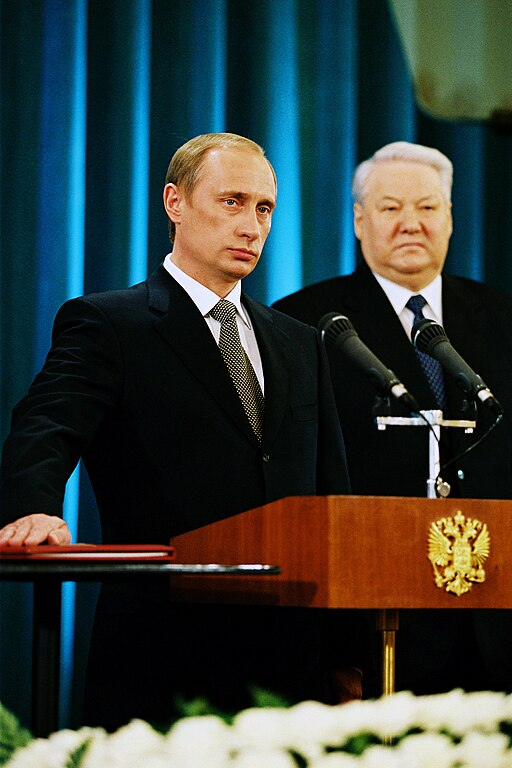Previous Subchapter → 3.2 The Wrecking Balls - Gorbachev and Yeltsin - 1980s-2000
It was only after the Yeltsin era, when Putin succeeded Yeltsin as President of Russia, that Russia truly began to recover and regain its prominence in the world, and the experience of being reduced to a political and economic laughing stock by the fall of the USSR, aided by Western support for Mikhail Gorbachev and Boris Yeltsin, left Russia especially wary of Western influence.
 Attribution: Kremlin.ru Licence: CC-BY 3.0
Attribution: Kremlin.ru Licence: CC-BY 3.0
Of course, the irony is that in some ways Putin benefitted from that influence: Putin was Yeltsin’s protégé, and the constitution forced through by Yeltsin with the backing of Western rhetoric and piles of cash gave the Russian Presidency immense power that Putin could rely on; But Russia’s first hand experience with Western inspired “democratisation” and privatisation was an absolute disaster, and this was something that laid heavy on Putin’s mind, the dramatic decline of Russian clout caused by the Soviet collapse is something he would stop at nothing to recover from.
For the few years of this project of his NATO stayed mostly quiet, its operations after the Yugoslav Wars were mostly defensive or non aggressive in nature, involving border security or anti piracy measures, and the one aggressive intervention NATO took part in in the early 2000s, the occupation of Afghanistan, was supported by Russia, however Russia did still face a major confrontation, over South Ossetia and Abkhzaia.
But in 2004, the dual problem of Post-Soviet conflicts and NATO expansion emerged, a new Georgian government had been elected with clear aims to reintegrate its lost territories, by force if necessary, the Georgian forces only backed down when Russian troops prepared to attack in retaliation, as for NATO, the alliance had a much wider expansion than in 1999, with 7 new nations joining, Bulgaria, Estonia, Latvia, Lithuania, Romania, Slovakia and Slovenia, this was significant because NATO now was not only expanding into the borders of the former Eastern Bloc, but into the borders of the former Soviet Union itself.
The second time this conflict flared up was in 2008 and this time it exploded, at the time US President George Bush had issued a statement in support of Georgia, and also Ukraine, joining NATO, and the US and Russia began carrying out rival military exercises in the region.
Shortly after the conflict between the Georgians and the separatists escalated into a Georgian attempt to retake seperatist territory, Russia responded by accusing Georgia of “genocide” and launching massive attacks against its forces, leading to the Russo-Georgian War.
After around 5 days the Georgians were forced to give up and retreat from South Ossetia and Abkhazia, leading to the same sort of uneasy peace as in Transnistria, but Putin made it clear that he planned further actions if the threat of NATO expansion persisted, warning that Crimea and other eastern regions of Ukraine would be swallowed up if the country moved to join the alliance.
These interventions drove a massive wedge between Russia and the West, with Western nations blasting Russia for invading Georgia, but crucially they didn’t take much real action, normal relations continued and Russia wasn’t made into a pariah, and on top of that, soon after this crisis US President George Bush was replaced by Barack Obama, who pursued a policy of “resetting” relations with Russia, the issue of Georgia was brushed aside, Russia essentially had gotten a free pass, leaving an impression in Russia that their peacekeeper mentality had been validated.
The reset with Russia didn’t last long, as the attempt to bridge the gap between Russia and the West was scuppered by NATO’s next major operation, Unified Protector.
In 2011 the country of Libya was plunged into a civil war between supporters of its government, the Libyan Arab Jamahiriya, and rebels seeking to overthrow it known as the National Transitional Council.
After a month of hostilities the Libyan government had retaken most of the rebel held ground and was advancing on the rebel capital of Benghazi, but just as the Libyan government’s advance began, NATO began their operation, Unified Protector, and attacked the Libyan Army, NATO airstrikes destroyed Libyan Army tanks and put a stop to the government advance, allowing the rebels to regain the initiative.
For months afterwards NATO airstrikes bombarded the Libyan Army across the country, destroying Tanks, Air Defence systems, Command and Control bases and more, this allowed the rebels, who on their own were outmatched by the Libyan Army, to sweep through Libya and take over the country.
NATO nations also intervened directly on the ground, training and offering support to rebel troops, even after denying that they would do so.
Operation Unified Protector proved to be divisive in the West, but in Russia the reaction was much stronger, with Putin bashing the “so-called civilised community” for attacking a “small country”, drawing comparisons with medieval crusades.
[Editor’s Note: Originally we were going to show Putin’s criticism through direct footage of his remarks, but we’ve had to change this because the clip we planned to use “Putin: Who gave NATO the right to kill Gaddafi?” was from RT, and EU law blocks us from reproducing RT content.]
After 7 months of fighting the Libyan government was overthrown and its leader, Muammar Gaddafi, was captured after a NATO attack on his convoy, he was tortured and killed by the rebels.
For Putin, this was further proof that NATO was a threat, in the Yugoslav Wars NATO had taken an offensive role against a non enemy government, but they didn’t destroy that government entirely or overthrow its leadership, in Libya the alliance had gone a step further, NATO’s intervention effectively led to the destruction of the Libyan government and the extrajudicial execution of its leader.